Rochdale Corporation Tramways
History
Rochdale became a tramway operator on the 22nd May 1902, when services commenced on its newly built standard-gauge electric tramway line from Dane Street to the Cemetery Gates on Bury Road. Although the corporation had advanced plans for an electric tramway system centred on Rochdale, it was hampered by a delay in acquiring the lines of the local steam tramway, which was owned by the Bury, Rochdale and Oldham Steam Tramways Company. This company had an extensive system (which ran on two gauges in Rochdale, standard and 3ft 6ins) encompassing Whitefield, Bury, Heywood, Rochdale, Royton and Oldham. Oldham had taken control of its lines (which it had always owned) in June 1902, but it was not until the 24th February 1904, that a binding agreement was finally reached — between the various local authorities and the company — on handing over the tracks and assets, and even then, the price the authorities would have to pay was still to be determined.
This agreement allowed Rochdale to take control of the tracks within the town to convert them to standard-gauge, overhead electric traction; meanwhile, the company continued to operate steam services whilst its lines were converted, one by one. The company's assets within Rochdale were finally handed over to the corporation on the 13th October 1904, the company presumably running its final steam service on the last remaining route — to Littleborough — the day before. The corporation was however not ready to begin the conversion of this route, so instead selected some steam engines and trailers (from its share of the BR&OSTCo's assets), commencing operations itself, presumably on the 13th October 1904, though the precise date appears not to have been recorded.
Rochdale also reached agreement with neighbouring Heywood Corporation to work a portion of its tramways once constructed. Negotiations with Heywood were however somewhat fraught, including an impasse which saw Heywood operating the old steam trams for 11 months, the Rochdale electric cars stopping at the municipal boundary (Heywood Cemetery) from the 13th April 1905 until the 20th December 1905, when the newly converted extension to Heywood Market Place was finally opened.
Like most tramway systems, Rochdale's emerged from the Great War in poor condition, with a large backlog or maintenance and deferred renewals, all needing attention at a time of rising costs and significant economic difficulties. The tramway made annual losses from 1920 to 1922, which though turned around in the mid-1920s, returned with a vengeance in 1929, continuing thereafter until closure in 1932. Despite the aforementioned challenges, track was renewed, new tramcars were procured (the last in 1928) and others significantly rebuilt.
Given the prevailing economic situation, it is perhaps surprising that in 1925 the corporation saw fit to buy the tracks and assets of the Middleton Electric Tramways Company within the borough (totalling 1.69 miles), the remainder being acquired by Chadderton Urban District Council and Middleton Corporation. The line southwards to Middleton was initially operated as a joint committee (from the 16th June 1925), but from the 9th August, services from Rochdale into Manchester (via Middleton) were operated as a joint service by Rochdale and Manchester Corporation Tramways.
Like many systems, Rochdale's was heavily impacted by unregulated bus competition during the 1920s, and in July 1925, it obtained powers to run buses itself, services commencing in early 1926. The buses immediately returned a profit, and the services were expanded accordingly. With more track renewals due, the tramway's days were clearly numbered, the first line to go being that to Littleborough and Summit on the 18th October 1930. In recognition of the transition to motorbuses, the 'Tramways Committee' was re-named the 'Transport Committee' in 1929. This change does not however appear to have been reflected in the tramcar livery, suggesting that the corporation was content to leave them as they were given the speed with which it intended to phase out the tram services.
Further tramway route abandonments followed quickly, no doubt in an attempt to stem the losses, the last tram of all running on the 12th November 1932.
At its maximum, the system extended to 29.92 miles of tramway, including 1.78 miles owned by Milnrow UDC, 2.84 miles by Littleborough UDC, 3.93 miles by Whitworth UDC, 1.58 miles by Bacup Corporation and 1.35 miles by Heywood Corporation. The system comprised lines: northwestwards to Nordland and Spotland; northwards to Bacup; northeastwards to Littleborough and Summit; eastwards to New Hey; southwards through Buersil to Thornham and through Sudden to Slattocks (from 1925); westwards through Sudden to Heywood Cemetery and along Bury Rd to Bamford.
The tramway met the lines of Heywood Corporation (at Heywood Cemetery), with Rochdale operating through to Heywood Market Place to connect with the cars of Bury Corporation. Eventually (in 1909), a through-running agreement was reached that saw Bury's cars run through to Rochdale, and vice versa. At Thornham — the boundary with Royton UDC — connection was made with the tracks of Oldham Corporation Tramways, which for a time (1906 to 1914) led to through-running between Hathershaw and Norden. The corporation's tracks also met those of Rawtenstall Corporation Tramways (4ft 0ins gauge) in Bacup and Middleton Electric Tramways Company (standard gauge) at Sudden, neither being physically connected. In 1925 however, Rochdale took over the northern portion of the former METCo line to Middleton, the lines being connected to the rest of the network at Sudden; a joint service was then run with Manchester Corporation Tramway; this saw Rochdale cars run through to High St, Manchester, and the MCT's run through to Oldham.
Uniforms
Rochdale Corporation was a steam tramway operator for around 7 months, spanning 1904/5, and photographs which can be securely dated to this period, clearly show that the corporation continued the latter-day policy of its immediate predecessor, the Bury, Rochdale and Oldham Steam Tramways Company (see link). Steam tram drivers therefore wore railway footplate-like attire comprising cotton jackets and trousers, invariably worn along with a cotton or flat cap; neither jackets nor caps bore insignia of any kind. Conductors wore informal but reasonably smart attire, comprising jackets, trousers, shirts and ties, along with the fashionable headgear of the day, by this time the flat cap. Once again, no badges or insignia of any kind were worn, including licences.
For the inauguration of electric services in 1902, staff were issued with double-breasted, 'lancer-style' tunics with two rows of five buttons (bearing the full system title and Rochdale's arms — see link) — narrowing from top to bottom — and upright collars; the latter bore individual 'R C T' initials on the right-hand side and an employee number on the left-hand side, presumably in brass to match the buttons. Caps were unusually squat with a soft top, and bore standard, 'off-the-shelf' script-lettering grade badges, either Driver or Conductor, again almost certainly in brass. The occasional early photo does however show that some conductors were issued with kepi-style caps, though these appear to have been quickly phased out in favour of the soft-topped caps. The kepi caps certainly bore a small municipal shield badge above the grade badge (see below), and though this cannot be easily discerned in surviving photos of staff wearing the soft-topped caps, it seems fairly likely that these caps also bore the same badge.
By 1905, and possibly earlier, the soft-topped caps had been replaced by a smarter, military-style of cap with a tensioned crown (top) — these continued to bear the script-lettering grade and municipal shield badges worn on the earlier caps, though Driver had by this time been replaced by Motorman. Staff were also issued with double-breasted greatcoats with two rows of five buttons, high fold-over collars and epaulettes; it is unclear whether these bore any insignia, though photos would suggest not.
Photographs of staff taken between the end of the Great War and the demise of the tramway in 1932 are surprisingly rare, so it is not possible to state with any certainty what uniforms were worn during this period. A photograph of several bus crews taken shortly after closure of the tramway does however show them in single-breasted jackets with lapels and epaulettes (see below), and it is possible that tramwaymen wore a similar uniform during the latter years of operation.
Inspectors wore single-breasted jackets with hidden buttons (or a hook and eye affair), edged in a finer material of a different colour to the jacket itself; these had upright collars which carried insignia, possibly 'R C T', though this cannot be made out with certainty. Caps were in a military style with a tensioned crown, and possibly bore the grade - Inspector - in embroidered script lettering, though this cannot be made out on surviving photographs.
During the Great War, and in common with the vast majority of UK tramway systems, women were employed to replace male staff lost to the armed services. Photographs of these ladies are however very scarce, but those that do survive suggest that they wore tailored single-breasted jackets with long skirts, and wide-brimmed bonnets. It is currently unclear what insignia were carried.
Further reading
For a history of the system, see: 'Tramways in Rochdale - Steam, Electric and Metrolink' by Tony Young; Light Rail Transit Association (2008).
Images
Steam tram drivers and conductors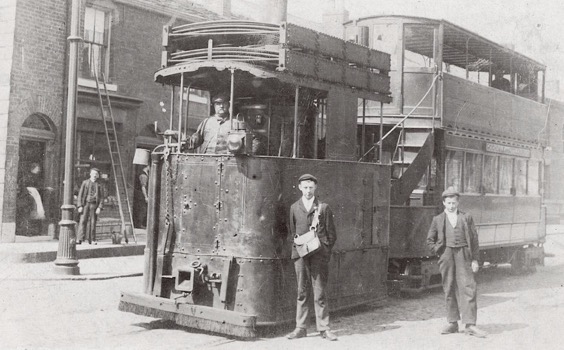
The crew of an extremely battered looking narrow gauge Wilkinson patent steam tram (a Beyer Peacock product of 1886) pose for the camera in Entwisle Rd, Rochdale with their Rochdale-Littleborough service — photo undated, but certainly taken during municipal ownership, i.e., 1904/5. Photo courtesy of the Richard Rosa Collection.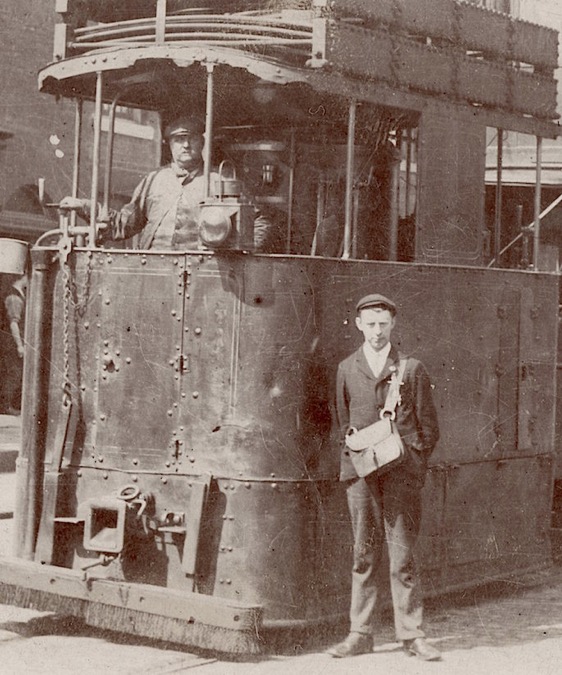
A blow-up of the above photo showing the driver and conductor, the former in typical grimy footplate attire with a flat cap and the latter in informal attire, again with a flat cap. Neither man is wearing a badge or licence of any kind.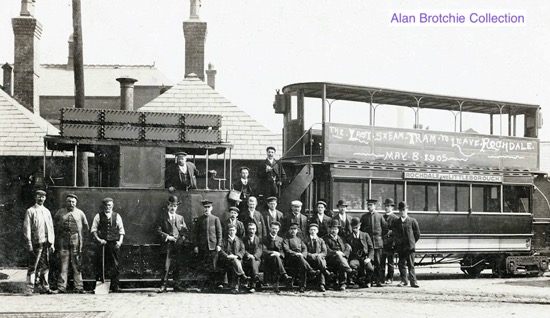
Steam tramway staff pose at Entwisle Road depot with the last steam tram from Rochdale — although the photographer has artificially added a date of 8th May 1905, official records indicate that the last tram actually ran on the 11th May.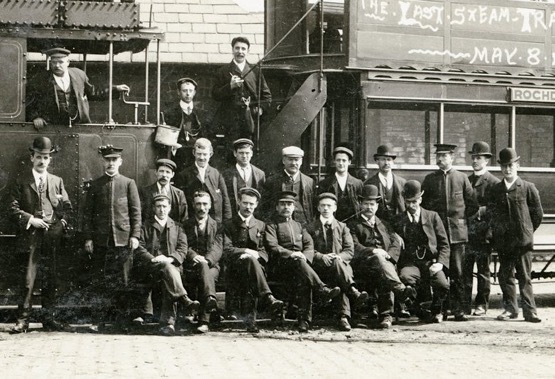
A blow-up of the above photo, which includes three inspectors, the only ones in uniforms.
Motormen and conductors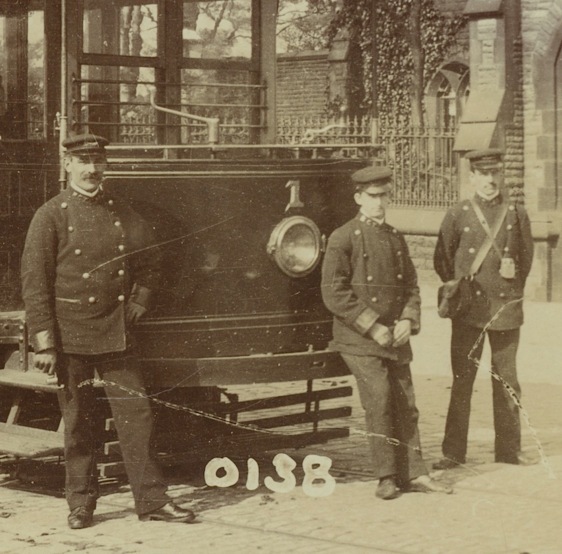
A driver, a trolley or points boy (?) and a conductor pose for the cameraman with a brand new Tramcar No 1 on the first day of operation on Rochdale's first electrified route along Bury Rd — photo taken on the 22nd May 1902. Photo courtesy of the National Tramway Museum.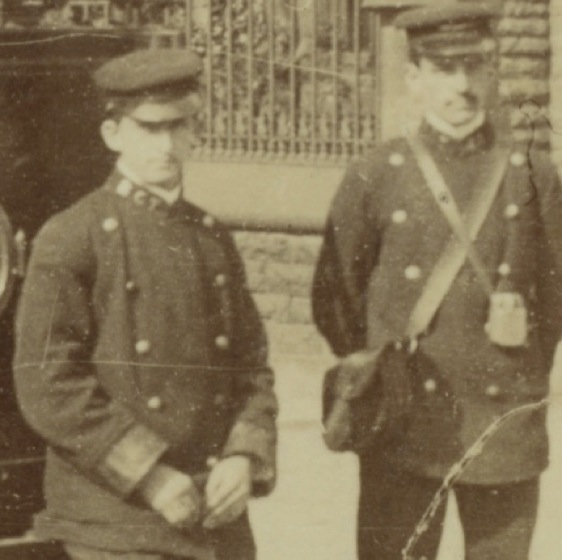
A blow-up of the above photo revealing ' R C T' initials on the right-hand collars and an employee number on the left-hand side.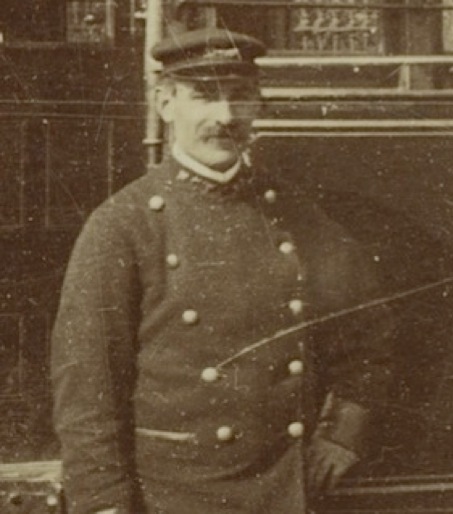
Another blow-up of the above photo, clearly showing that the motorman is wearing a script-lettering cap badge - Driver.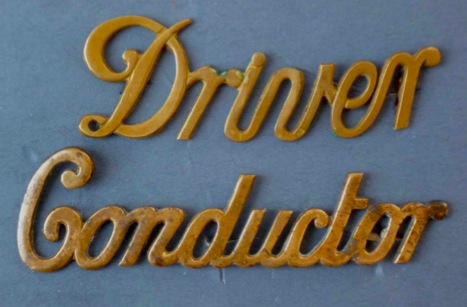
General pattern script-lettering cap badges of the type used by Rochdale Corporation Tramways — brass. The Driver badge was relatively quickly superseded by a Motorman pattern, probably within the first one or two years of opening. Author's Collection.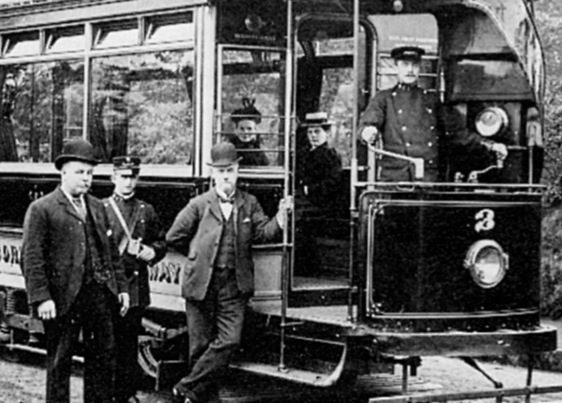
A number of individuals pose with Tramcar No 3 at the Dog and Partridge terminus on Bury Rd; photo dated 1902, though in all probability it was taken in 1903 given that the extension from Cemetery Gates to the Dog and Partridge was only opened then. Whilst the motorman is clearly wearing the same uniform and cap as in the previous photo, the conductor appears to be wearing a kepi-style cap with a script-lettering cap badge and small badge above, almost certainly the Rochdale municipal shield badge shown below. The latter was probably used on the soft-topped caps as well, but is obscured on most photos by the wide crown of the rather squat cap. Photo courtesy of the Tramways and Light Railway Society.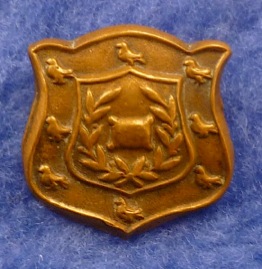
Rochdale Corporation Tramways municipal shield cap badge — brass. Author's Collection.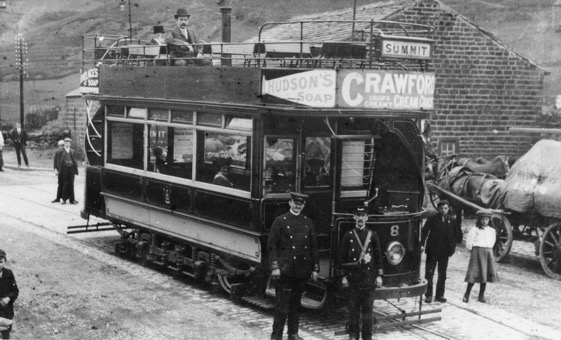
A motorman and conductor with Tramcar No 8 at Summit — photo undated, but probably taken in 1905. Author's Collection.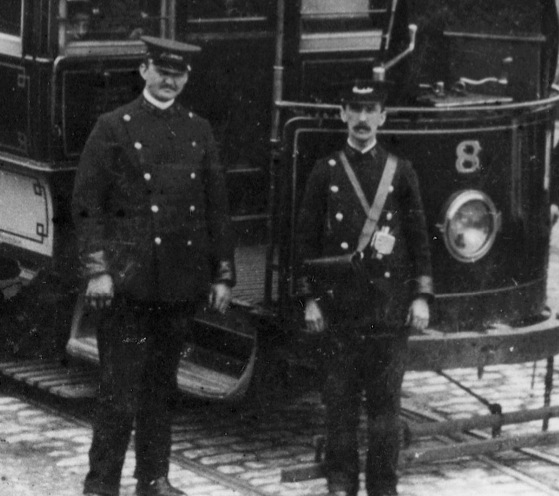
A blow-up of the above photo, revealing that the motorman is wearing a Motorman script-lettering cap badge.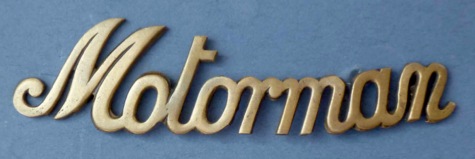
General pattern script-lettering Motorman cap badge, used by Rochdale Corporation Tramways from about 1905 onwards — brass. Author's Collection.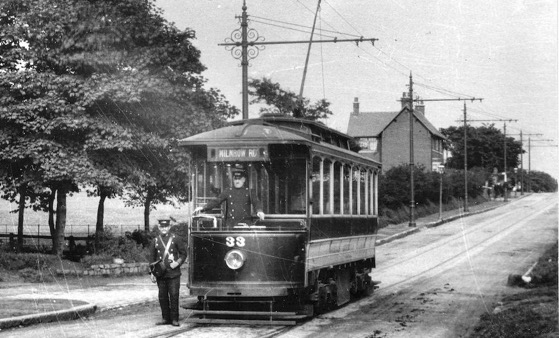
A conductor and driver in Bury Rd near the Dog and Partridge with Tramcar No 33 — believed to have been taken in 1905. Photo courtesy of Duncan Holden.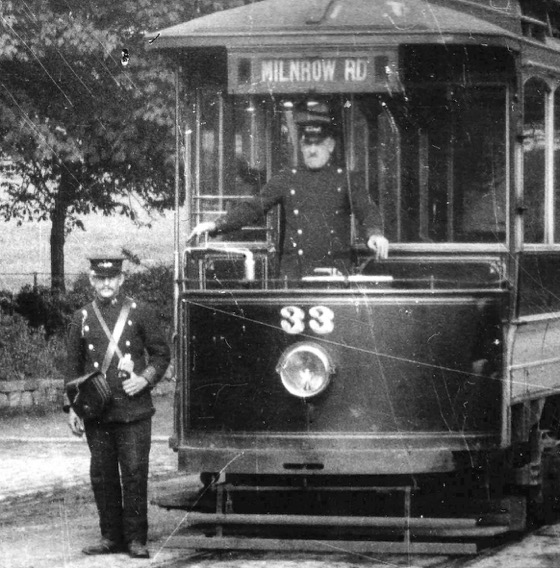
A blow-up of the above photo showing the tramcar crew. 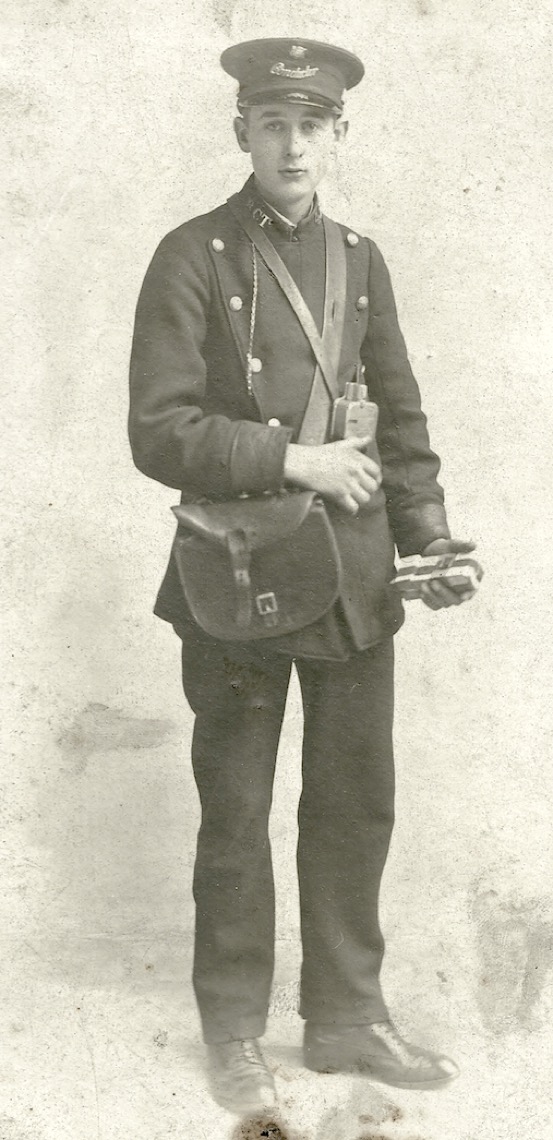
RCT conductor — photo undated, but probably taken before the Great War. Photo courtesy of the Stephen Howarth Collection.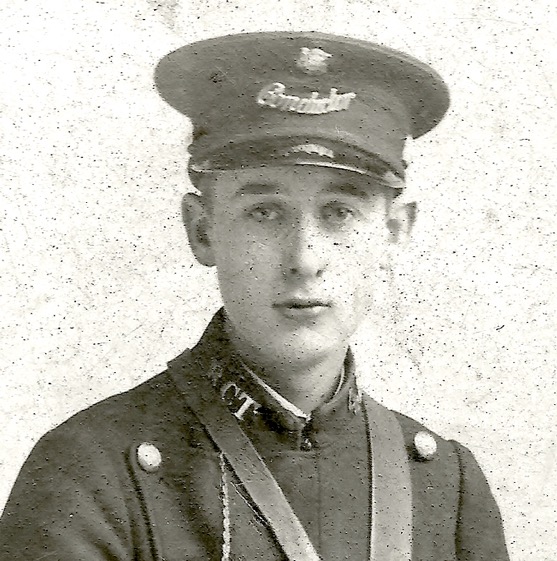
A blow-up of the above photo showing details of the collar and cap insignia.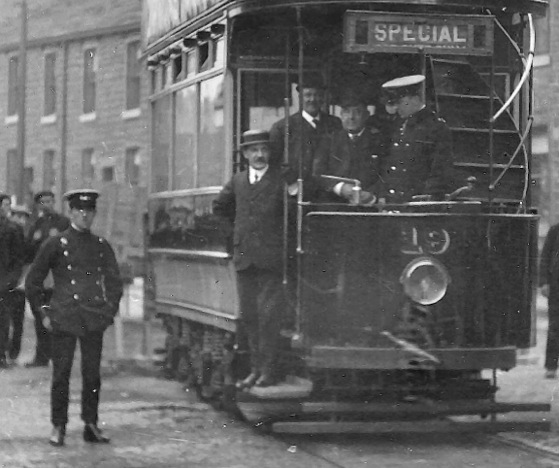
Tramcar No 19 and crew with the Board of Trade inspection in Whitworth on 14th June 1910. Both men are wearing white rain covers on their caps, indicating that it was summer. With thanks to Duncan Holden.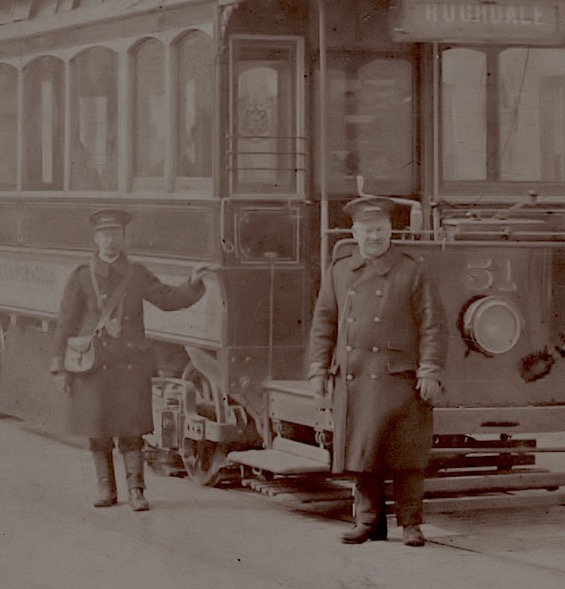
Greatcoated conductor and motorman pose for the camera alongside bogie car No 51 — photo undated, but judging by the good condition of the tram, probably late Edwardian. With thanks to Stephen Howarth.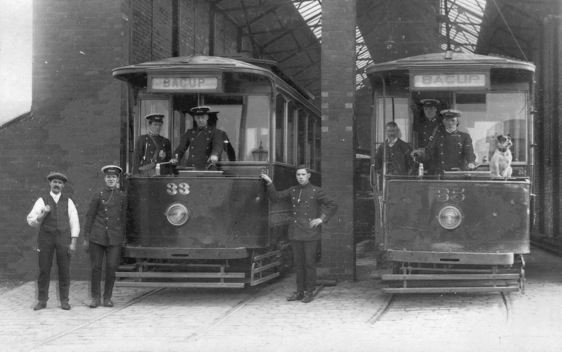
Tramcars No 33 and 35 at Bacup Depot — photo undated, but probably taken not long after opening in 1911. With thanks to Duncan Holden.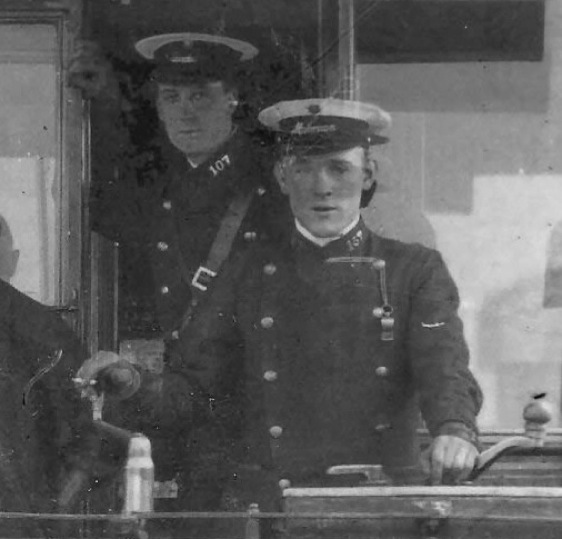
A blow-up of the above photo showing the crew of Tramcar No 35 — Conductor 107 and Motorman 137. The Rochdale municipal shield badge is worn high on the cap, above the script-lettering grade badges, and almost under the crown.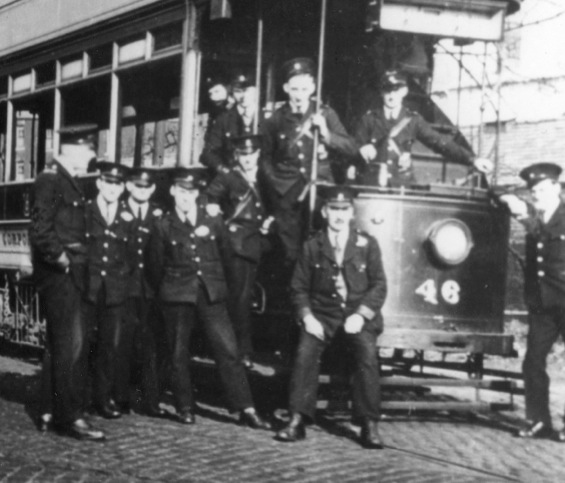
A group of Rochdale Corporation Transport bus men pose alongside a line of tramcars awaiting scrapping — photo taken on 25th March 1933, some four months after closure of the tramway. Although this style of uniform may have been worn by tramcar crews in the latter days of tramway operations, there is currently no photographic evidence to either support or refute this. Author's Collection.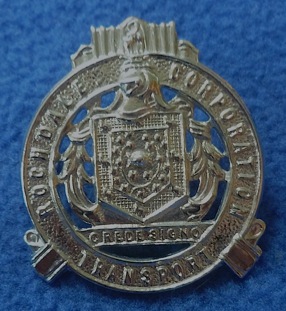
Rochdale Corporation Transport cap badge — chrome. There is currently no evidence that this style of badge was ever worn by tramways staff. Author's Collection.
Senior staff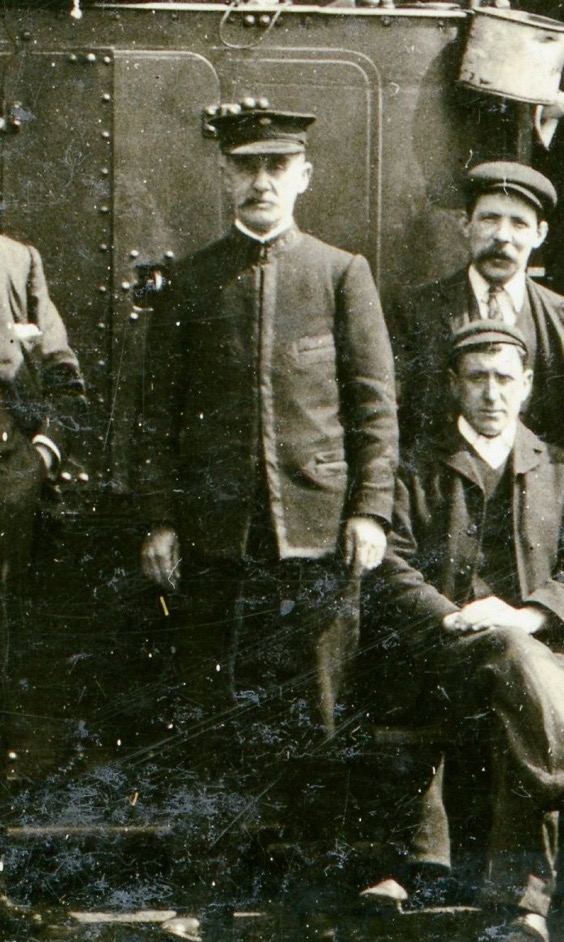
A blow-up of the 1905 Entwistle steam tramway staff photo above showing an inspector, or perhaps a chief inspector.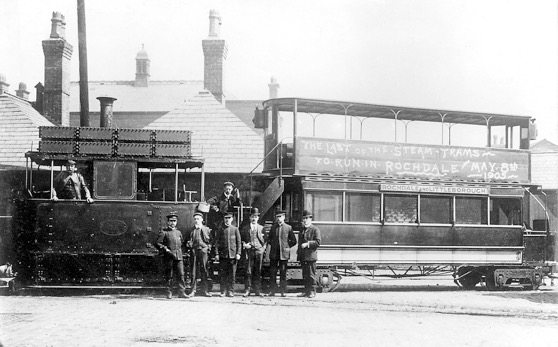
Another photo taken at Entwisle depot to commemorate the end of steam services, and almost certainly on the same day as the full staff photo shown above, along with the same spurious date added to the trailer (by the photographer). Photo courtesy of David Gladwin, with thanks to Trevor Preece.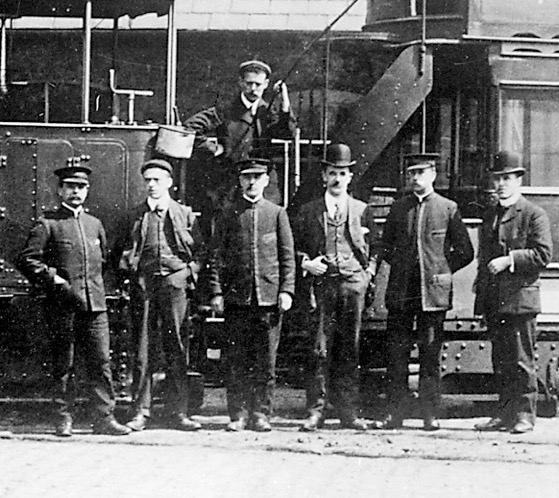
A blow-up of the above photo showing the assembled inspectors (three in total), along with several individuals who presumably represent more senior echelons within the corporation.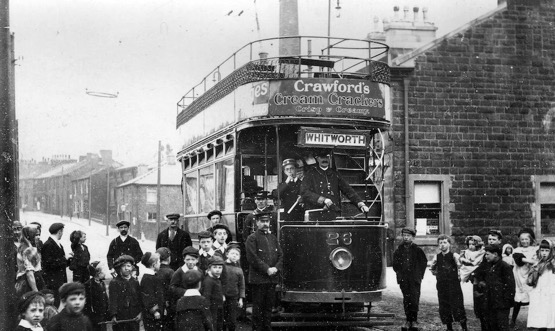
A conductor, inspector and motorman pose for the camera with Tramcar No 26 in Shawforth, probably in July 1911 when the route opened. With thanks to Duncan Holden.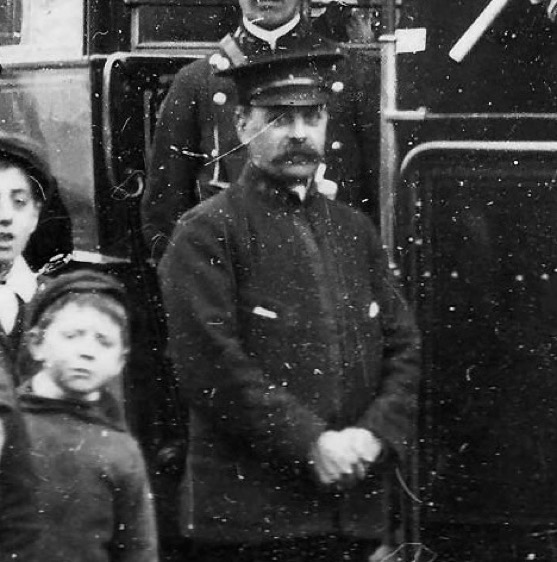
A blow-up of the photo above, showing the inspector — his cap appears to bear no insignia, though it may well be in shadow. With thanks to Duncan Holden.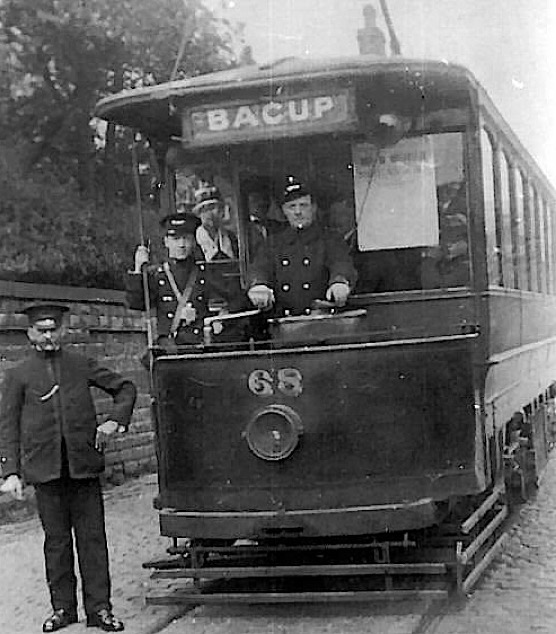
An inspector poses for the camera with the crew of Tramcar No 68 — photo undated, but probably taken shortly after the Great War given that no 68 was new in 1912. The location is Shawforth, next to Shawforth Chapel. With thanks to Duncan Holden and Adam McKendrick.
Female staff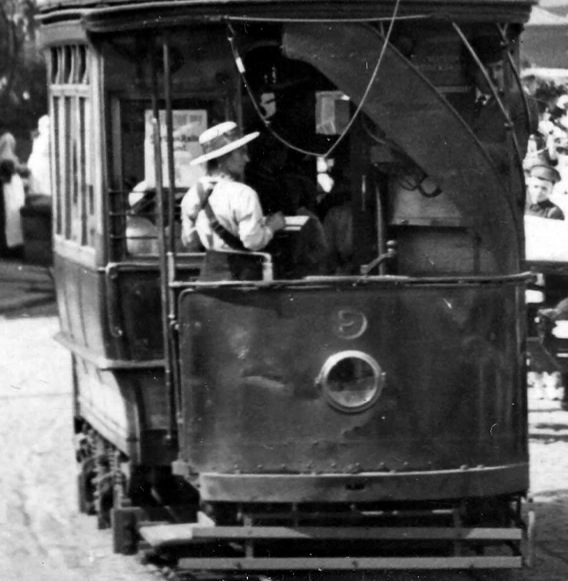
A rare shot of a conductress aboard Tramcar No 9 with a service to Norden, taken at Whitsuntide 1916. The lady in question is wearing a white blouse and straw bonnet, with no jacket. With thanks to Duncan Holden.